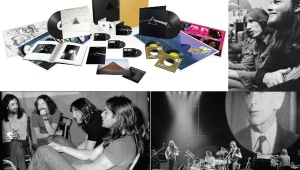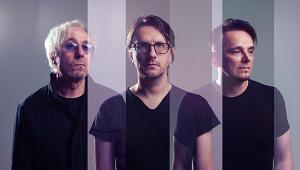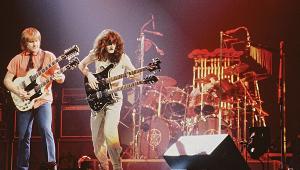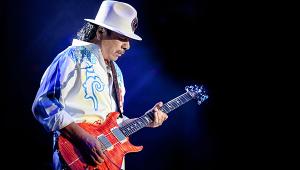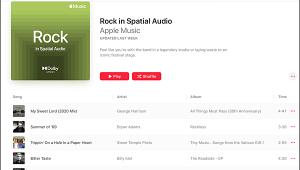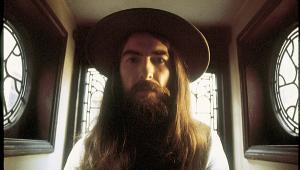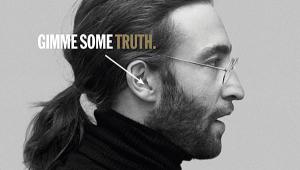Magic Before and After: Peter Jackson’s “Now and Then” Music Video
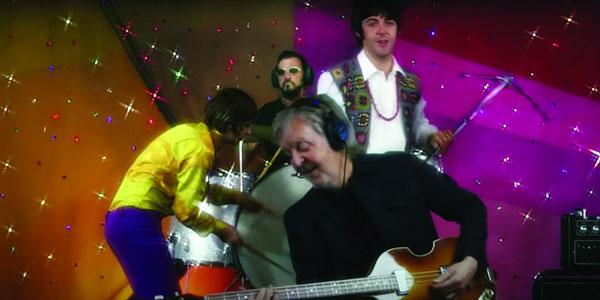
It starts with Paul and George tuning up their acoustic guitars, during the February 1995 sessions for the recently-released final Beatles tune, “Now and Then.” Before long, we’re being reminded of just whom their brother, John, misses every so often and why, in a way that both stirs our hearts and also makes us smile.
The music video—director Peter Jackson’s first ever—premiered on Friday, November 3, 2023, the day after the release of the single itself. The film is a mix of historic footage, beautifully restored, and recent footage of Paul and Ringo in their respective studios. And, at times, some of The Beatles from their early days (mostly 1967) appear in modern footage, joining the festivities in ways that are very much in line with The Fabs’ own sense of humor about themselves.
Though he had been asked before to do music videos, Peter had always politely declined. And, as the director noted in a statement issued a few days before the video’s debut, he hoped “that tricky task was somebody else’s problem, and I could be like any other fan, enjoying the night-before-Christmas anticipation as the release of a new Beatles song and music video approached,” such as in November 1995, when the group’s first new song in 25 years, “Free As a Bird” was released, accompanied by a magical video from director Joe Pytka.
The responsibility for taking on the video of the last Beatles song was a big one, and, he notes, he tried to find a good reason to turn Apple down (“In fact, I still haven’t, to this day”), after Apple producer Jonathan Clyde asked him, during a visit to New Zealand in February 2023. But, he notes, “The Beatles don’t take no for an answer if their minds are set on something.” Said Jonathan, in an interview with Variety’s Chris Willman, “This was almost like a proposal he couldn’t refuse.”
Thinking like the storyteller he is, Peter’s biggest concern was a lack of footage to use in the film. “We’d need to use a lot of rare and unseen film, but there’s very little,” he says, including footage of Paul, George and Ringo working on the song in 1995 nor, apparently, footage of Paul and Ringo working on it in 2022—or even of John himself in the mid-70s, when he wrote the song. “A Beatles music video must have great Beatles footage at its core,” he states.
But Apple quickly began to address his concerns. Besides new footage of Paul and Ringo in their studios, Jonathan notes, “We did find some footage we thought we didn’t have of them recording ‘Now and Then.’ It was just on another tape that was not marked up that way. So that was an absolute breakthrough,” some 14 hours worth of long-forgotten film, which was provided to Peter. “Watching this footage completely changed the situation,” the director says. “I could see how a music video could be made.” He began thinking of the project as something he was more familiar with—a short film, telling a story, versus a music video.
.jpg)
2022 Ringo is joined by his 1967 self at his Rockabella West Studios in L.A. to record his new drum track for “Now and Then” - © Apple Corps, Ltd.
There was also a precious few seconds of never before seen footage of The Beatles in the earliest days, performing onstage, still dressed in their pre-Brian Epstein leather attire, kindly supplied by Pete Best himself. And Sean Lennon and Olivia Harrison provided some unseen home movie footage, as well.
As for his story approach, it was the song itself that began to inspire and guide him. “After we had separated John’s voice on the demo tape the year before, Giles had produced an early mix,” the director recalls. “I loved it and must have listened to it over 50 times, purely for pleasure. But now I started listening to it intently for different reasons. I was hoping that ideas or inspiration for the short film would somehow float up from the music, and that began to happen. As I kept listening, it felt like the song was creating ideas an images that started forming in my head.
He began working with his award-winning editor, Jabez Olssen (Emmy® for Get Back), to figure out ways to use the newly-acquired footage (plus archive material from Apple) to pull those ideas together. “It was a very organic process,” he describes. “We slowly started to build little fragments, sliding pictures and music around in different ways until things began to click.”
.jpeg)
Paul listens to the 2022 string session in the control room at Capitol, accompanied by his and George’s 1967 selves. Credit: ©Apple Corps, Ltd.
The thinking was, “We wanted the short film to bring a few tears to the eye. But generating emotion using only archive footage is a tricky thing.” But, he says, “The simple power of this beautiful song did a lot of the work for us, and we finished the first 30 or 40 seconds of film fairly quickly.” Then, they built the ending, in a similar fashion, “and tried to craft something that could adequately sum up the enormity of The Beatles’ legacy—in the last few seconds of their final recording. But this proved to be impossible. Their contribution to the world is too immense.”
So as the great storyteller that he is, he decided to let the viewer’s own imagination do what they couldn’t, “and have each viewer create their own personal moment of farewell to The Beatles. But we had to gently steer everyone to that place. I had some vague ideas,” one of which he indeed used to end the film—a montage of images, bringing us back in time with each Beatle, to their earliest days, ending in a bow to the audience, taken from A Hard Day’s Night.
The two filmmakers had their start and their ending—but what about the middle? They realized that continuing in that emotional vein was not the right approach. “That was not who The Beatles were,” Peter says. “At their core, they were irreverent and funny, and the middle section should capture that spirit. We needed to laugh at The Beatles—and laugh with them. They were always sending themselves up. And the more seriously other people took them, the more they would clown around.”
Apple made available some more never-seen footage, outtakes and trims from the three promotional films The Beatles had shot in November 1967 for their then-new single, “Hello Goodbye. “They had made three versions,” says Jonathan Clyde. “One was a straight one, then a semi-straight one, and then a sort of crazy one. There were lots of trims and outtakes, and so that’s where that footage came from that Peter was able to play with and have fun with.”
Peter and Jabez carefully began interweaving not simply the raw footage from the “Hello Goodbye” shoot in between other clips, but instead inserting the Beatles from those clips as characters into scenes, skillfully executed by WētāFX, Peter’s company’s visual effects arm. And they’re not simply inserted into existing shots—the two find appropriate reaction shots in the current footage to make it appear to us as if this is all really happening.
For example, a goofy John is, during footage from the May 1, 2022 string session for “Now and Then,” clowning around at conductor Ben Foster’s podium (with Ben removed and John in his place), while string players give judgmental looks, and Paul chuckles as he looks out from the control room window. Or 1967, George and Paul were there at either side of modern Paul in that control room, as he looked left and right at them. And 1967 Ringo is placed to 2022 Ringo’s right, in his home studio in L.A., both playing the new drum track together to “Now and Then.”
.jpeg)
The 1967 John appears to be conducting the 2022 string session at Capitol. Credit: ©Apple Corps, Ltd.
The bits not only work because of the smart choices Peter and Jabez made in finding great reaction clips, but also because of the years of experience WētāFX bring to such shots. Putting George in a shadowy control room next to Paul means building lighting for George so that he appears in the same manner as Paul does and layered in between pieces of furniture in the room, as Paul is. In less skilled hands, the shots would just be cheap gags rather than thoughtfully planned bits of story for us to enjoy.
Upon its completion, Peter realized his worries over whether he could create an appropriate sendoff for The Beatles’ legacy were no longer needed. “Having got to the end,” he says, “I’m very happy I’m not waiting for the release of somebody else’s ‘Now and Then’ music video. I have genuine pride in what we made, and I’ll cherish that for years to come.”
This article is an accompaniment to the feature "The Creation of The Beatles’ Last Song and the Rebirth of Red and Blue" that you can read here.

